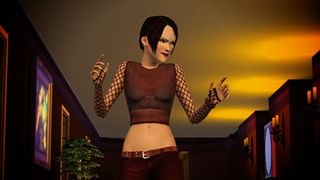The Sims 3 – hands-on
It's a Wonderful Life
Micro-managing compulsives, on the other hand, will go nuts over the new customization options, like applying custom textures to most of the objects in your Sim’s house, an option that, in my case, led to the creation of an interior design atrocity involving matching plaid sofas, wallpapers, and refrigerator. Add a modest 4,000,000 fans with that one.

Executive Producer Ben Bell sums up for me the difference between The Sims 2 and The Sims 3 with a very compact description: “It’s not about spinning plates.” The Sims 2 and its expansion packs put players in a series of environments and left it up to them to make sure that everything didn’t collapse into death, decay, or catfights. Not anymore. Now you’re given the cheerful, thriving miniverse of Pleasant Valley to raise a Sim family in, and you’re tasked with guiding the semi-autonomous Sim of your choice on the path of his or her greatest fulfillment. That path is determined by a set of five personality traits, ranging from Charismatic and Computer Whiz to Neurotic and even downright Evil, that inform each Sim’s aspirations.
Instead of intervening when your Sim is on the verge of killing himself, your job might be to push a charismatic and egotistical young man toward a political career, or an evil computer whiz up a career ladder as a criminal until she’s kissing her husband on the forehead before taking a taxi to an abandoned warehouse and putting the finishing touches on her plan to subjugate the entire world to her cruel and capricious nature. These accomplishments add to your Sim’s overall happiness, paying off in bonuses that make them even easier to manage, like a Steel Bladder that makes going to the potty unnecessary, or a Super Green Thumb that lets your Sim grow his own food.

That’s worth at least another 14,000,000 million fans, and I’m beginning to see where EA got the idea to add world domination as an ultimate goal in The Sims 3.
Feb 26, 2009
Sign up to the GamesRadar+ Newsletter
Weekly digests, tales from the communities you love, and more

5 million people played Fallout games in a single day, with Fallout 76 alone accounting for 1 million, amid the TV show's massive success

15 days after Wii U servers were supposed to be shut down, the last surviving Splatoon player is still hanging on as the servers crumble around them

Al Pacino and The Guest star to play priests in a new exorcism horror movie based on a true story
Most Popular


